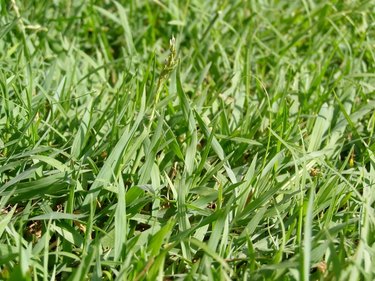
You may have heard of grass whistling or recall using blades of grass to whistle at camp or on the school playground. This acoustic exercise is easy to replicate anywhere, and it can be fun to discern the best types of grass to produce particular sounds and to manipulate the grass and your hands to change the sound. Understanding how grass whistling works can further increase your skills.
How Whistling Works
Video of the Day
It may surprise you to learn that grass whistling is not a form of whistling at all. A grass whistle is technically a type of reed instrument that is similar to woodwind instruments, like the clarinet. To understand the difference and to be able to manipulate your grass and hands to produce the desired sound, it's helpful to understand a little about the science of sound.
Video of the Day
Grass whistling relies on the same science as woodwind instruments, starting with the basic idea that sound is caused by vibration. The vibrating string of a plucked guitar and the string inside a piano that is struck by a hammer when the corresponding key is depressed are examples, as is the skin of a struck drum.
These vibrations cause waves of compression of the air molecules surrounding the source, and these sound waves eventually reach your ear, where they cause vibrations of your eardrum.
More About Whistle Functioning
In the case of a true whistle, it's the air itself. The simple iconic whistle used by referees and sports coaches works this way. Air is blown into the mouth end of the whistle and travels around the circumference of the circular shape until it circles back to meet the incoming stream, creating an area of high turbulence before it escapes through the small hole at the top. This turbulence causes vortices at the exit site, which are the vibrations that cause the shrill whistling sound.
However, whistling with a piece of grass instead works like a reed instrument. In a reed instrument, the reed vibrates, changing the size of the opening through which the air flows. When grass "whistling," the grass acts like a reed in a reed instrument.
Grass Whistling Basics
To actually do some grass whistling, first pick the appropriate type of grass. The blade should be at least as long as your index finger but preferably should be 6 inches to allow you to play with the tension along its length. Wide, flat, coarse blades work better than thinner ones. Pick a variety with which to experiment to obtain different types of sounds.
It's a good idea to wash the grass to get rid of any dirt and possible animal urine. Avoid using any grass that has been treated with pesticides or herbicides. After washing the grass, thoroughly pat it dry. Dry grass works better than wet grass, and this also applies to grass after rain or near sprinklers.
Once you have your lengths of grass, take one in your left hand with your thumbnail facing toward you. Hold the blade of grass with your index finger against the outside of your thumb so that it drapes down along the length of your thumb. The flat side of the grass should be against the side of your thumb, and the thin edge should be facing you. Gently use the rest of your fingers, mainly your middle finger, to draw the grass taut against the side of your thumb and palm.
Next Steps for Music
Next, press the outer edge of your right hand (with your thumbnail facing you) against your left thumb with the blade of grass between them, making sure the grass stays taut. You should end up with your thumbs against each other, thumbnails toward you, with a small space in the middle with the blade of grass down the center with its thin edge toward you. Adjust your thumbs and palms to correct the tension in the grass.
To play the grass, purse your lips against the space between your thumbs where the thin edge of the grass is and blow through the small space. This should produce a loud sound. Close your hands in loose fists to create a chamber behind your thumbs and change the sound. You can adjust the position of your hands, the force of your exhalation, the tension in the blade of grass and the shape of your lips to produce different sounds. Different types of grass or even each individual blade of grass will also produce different sounds.